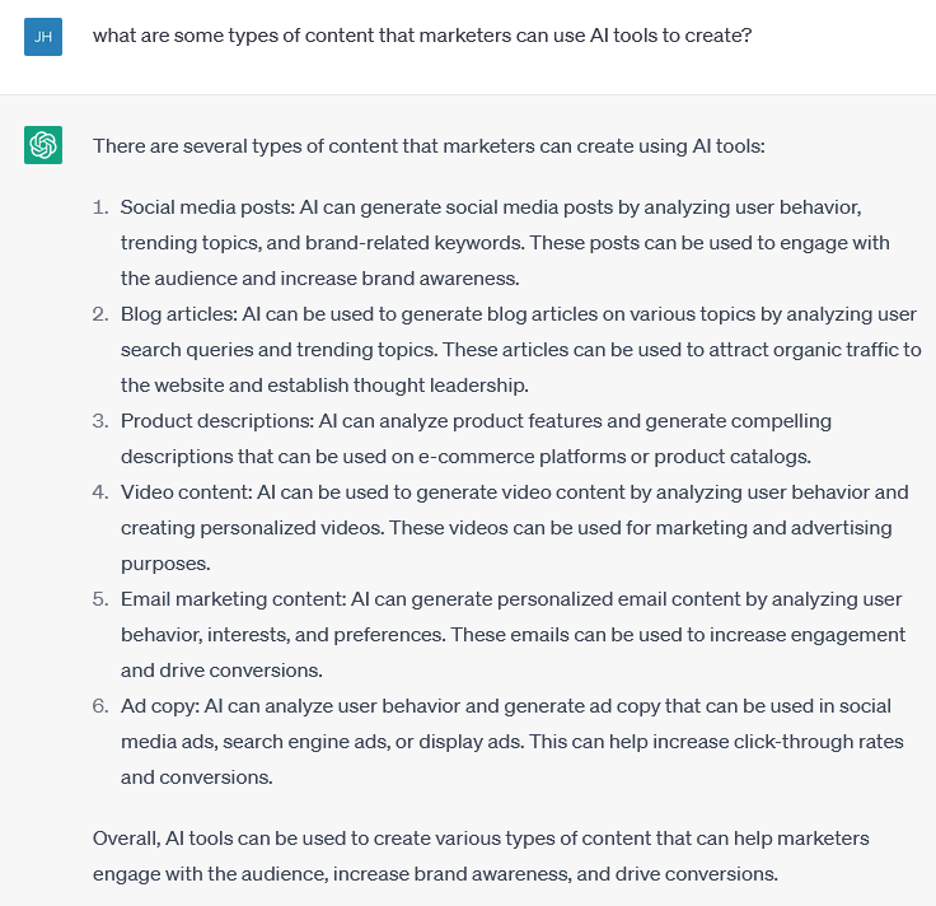
TLDR: Regardless of how you feel about them, AI tools like ChatGPT are here to stay. At Media Shower, we’ve spent the last year researching AI tools, and developing the following five principles for using them effectively:
- The solution is not AI or humans, it’s AI and humans.
- AI is a powerful research tool, helping prepare content before it’s written.
- AI is a powerful writing coach, helping improve content after it’s written.
- Any content generated by AI in between should be treated like any other research source (i.e., quoted and sourced).
- As AI evolves, these rules may change.
When used with these principles, we’ve found AI tools are a powerful accelerant for creating content that’s 10x better.
SO WHAT? Developing principles for working with AI is not just important for business, it’s important for humanity. Our approach is to accept that AI is rapidly transforming our business (and yours), and to see that challenge as an opportunity to make our work 10x better.
“AI is not a futuristic dream, it’s already transforming industries and the world around us.” – Satya Nadella, CEO, Microsoft
What Is AI-Generated Content?
AI content writing is the process of using artificial intelligence to generate content like blogs, emails, and social media posts. AI writing tools like ChatGPT are exploding in popularity, as they can save writers (and marketing teams) time and money.
We’ve found AI to be an incredible research tool and a powerful writing coach. However, blindly asking AI to produce blog posts and web pages can vary in quality, depending on the input parameters (also known as “prompt engineering“).
The quality of the input determines the quality of the output. In other words, well-written prompts for tools like ChatGPT will produce much better results.
The acronym we’ve invented is BIBO: Better Input = Better Output.
Consider the difference between this prompt:
Write me a blog post about data governance
And this one:
Write me a blog post about data governance, targeted to a professional CTO audience. Include the top 10 frequently asked questions from an executive at that level, and include high-value SEO keywords as H2 tags.
Good writers have a superpower: they’re able to develop incredible AI prompts, much better than the average user.
Again, it’s not just AI, or just humans: it’s the skill of the humans using AI. It’s both.
Good AI + Good Human Input = Better Content
How Did We Get Here?
Since the early 1960s, artificial intelligence has been successfully used to generate content. It started with rudimentary text-based programs capable of generating simple words and phrases from datasets. It’s become increasingly sophisticated over time, and now uses Large Language Models (LLMs) procured from the Internet to produce text on any subject imaginable.
 In the 1960s, Dr. Joseph Weizenbaum developed ELIZA, a program that mimics conversation through analyzing keywords, replying with responses that were frequently vague or based on an insufficient knowledge of context.
In the 1960s, Dr. Joseph Weizenbaum developed ELIZA, a program that mimics conversation through analyzing keywords, replying with responses that were frequently vague or based on an insufficient knowledge of context.
The first attempts at natural language processing (NLP) and machine learning (ML) occurred in the 1970s. More sophisticated AI systems emerged in the 1980s, allowing for greater levels of complexity like summarizing texts and answering questions.
AI was used in a number of applications by the 1990s, including automated customer service bots, automated news articles, and virtual assistants.
Today, AI is more sophisticated than ever. AI can generate high-quality content that targets specific audiences because of advancements in NLP and ML algorithms. (If you haven’t used ChatGPT yet, it makes Google look like a children’s toy.)
“AI is not a silver bullet, but a tool for augmenting human intelligence.” – Fei-Fei Li
AI Content Generation Use Cases

Courtesy ChatGPT
Some of the companies using AI content:
- The Washington Post launched Heliograf, a platform that uses artificial intelligence to generate news pieces about sports, elections, and other data-driven topics.
- Forbes introduced Bertie, an AI-powered tool that produces automated suggestions for story headlines and summaries based on the content of the article.
- Associated Press uses Wordsmith, a program that generates news pieces and financial statements automatically from data, leaving reporters free for more important duties.
- Shutterstock introduced Shutterstock Editor, an AI-powered application that allows users to generate unique social media visuals and other digital material.
AI Content Generation Tools for Marketers
- ChatGPT: ChatGPT is a language model that generates high-quality text based on user prompts using the GPT-3 architecture. It has a wide range of uses including content generation, chatbots, and more.
- Copy.ai: Copy.ai is an AI writing assistant that may benefit marketers in quickly and easily producing content like headlines, product descriptions, and social media postings.
- Rytr: Rytr is a platform that uses AI to generate written content including blog posts and product descriptions. It creates engaging content using powerful NLP algorithms.
- DALL-E: DALL-E is an OpenAI neural network that produces images and visuals from textual descriptions (like “a banana doing a happy dance”). It is useful for creating visual marketing content like social media post images and infographics.
- Amper Music: Amper Music (now merged with Shutterstock) is an AI-powered platform that can generate unique music tracks in a given mood or style, making it an excellent tool for creating video commercials, podcasts, and similar content.
- StarryAI: StarryAI is an AI-powered art generator that can create unique and original art pieces based on user prompts, making it an excellent tool for designers and marketers.

“a banana doing a happy dance” (Courtesy Dall-E)
Is AI Content Writing Right for Your Business?
Generative AI has become a hot topic in the marketing industry. It promises to revolutionize the way marketers create content, but in our experience over the last year, it has both pros and cons.
Pros:
- Helps marketers create better content faster
- Saves time and resources
- Writes content for any topic
- Gets better with more data
- Makes the process relatively easy
Cons:
- No guarantee that content is factually correct
- Requires human editors to add images, links, CTAs, etc.
- Risk of plagiarism
- Not accepted in many fields
- No originality, as all text comes from previously established ideas
The technology is still in its early stages and has limitations in determining context and nuance. AI algorithms are data driven, so if the data is biased or inaccurate, the output could be skewed or faulty.
Despite this, businesses can use AI-generated content for the initial foundation, then refine it with human editors and producers like the team at Media Shower, resulting in outstanding content that’s produced efficiently and cost-effectively.
Media Shower’s Recommendations for AI Content Writing
The answer is not AI or humans, it’s AI and humans.
We have found a hybrid method that makes use of both AI and human innovation. While AI-generated content can give fantastic starting points for copywriters and marketers (the research phase), and outstanding editorial skills (the editing phase), it requires a lot of human effort to write prompts, rewrite output, make web-friendly, and ensure quality and accuracy.
Here are some rules of the road:
- Use AI as a tool, not as a replacement for human creativity: While AI-generated content can be a terrific place to start for copywriters and marketers, human creativity is still needed. (AI is terrible at finding your customer stories, or writing zinger ad copy.)
- Consider tone and style: AI-generated material can lack the personality and inventiveness of human-generated content. (It starts to all sound the same.) Humans need to punch it up for tone, style, and brand voice.
- Use AI for greater efficiency: AI can save tons of time in the research and brainstorming phase. Use AI tools for jobs like data analysis, topic generation, and content research, freeing up human editors to focus on the creative aspects of content development.
- Don’t compromise quality for speed: While AI-generated content can be created rapidly, it’s critical not to compromise quality for speed. Human editors should remain involved in the process to ensure the content is accurate, relevant, and factually correct.
- Test and evaluate outcomes: Like any content creation approach, AI-generated content should be tested and measured to make sure it’s working. Track your long-term metrics like SEO ranking, traffic, and conversions, and course correct as necessary.
Media Shower is laying the foundation for a better way to work with AI-powered content generators, while using human editors to ensure quality, consistency, and results.
For our entire AI content series, subscribe to the Media Shower newsletter and join thousands of marketers who are making their content better.